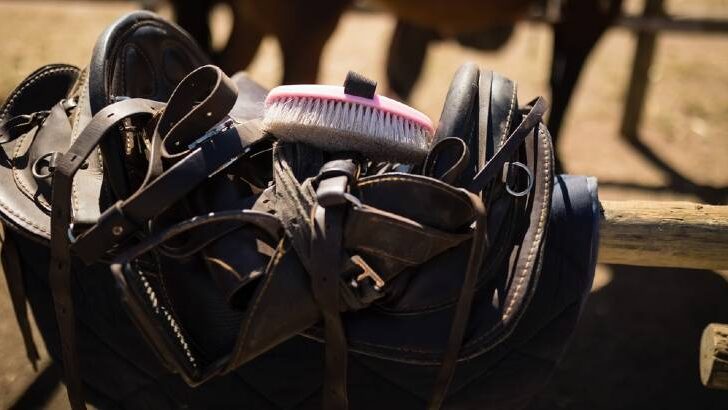Affiliate Disclaimer
As an Amazon Associate I earn from qualifying purchases. It helps me keep the website going. Thank you for your support.
We are all familiar with making sure we check our food for mold before we eat it. Things like bread, if stored incorrectly or for a long time, can very easily go white and fuzzy! But do you make sure things like your horse tack and equipment are protected from mold and do you get mold off horse tack?
Mold can cause extensive damage to horse tack and equipment if left untreated. It is important to follow the correct process to get mold off horse tack and ensure that you actually kill the mold, and not simply wipe the excess off. These nasty fungi spread very easily, so you must take precautions to prevent mold from taking over your tack room.
Investing in horse tack items like saddles, bridles, and rugs can be expensive and because mold can be very destructive, it can cause you to have to shell out funds to replace items prematurely. Read on to learn more about mold and how to protect your tack!
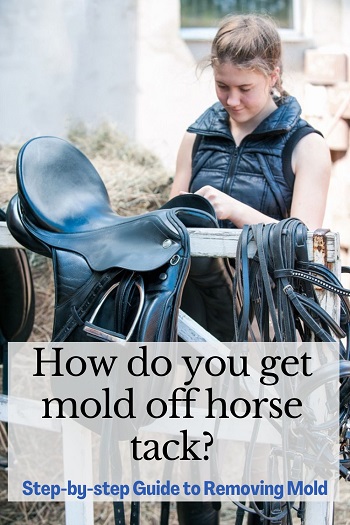
Why Does Mold Grow On Horse Tack?
Mold is a naturally occurring fungus and there are thousands of different types of mold in the world. The fungus spreads by producing spores, and can range from an obvious white fuzz to a slight stain or discoloration. It loves moist and poorly ventilated areas to grow.
Horse tack is often kept well-conditioned, and is subject to rain, mud, and sweat, which can lead to high moisture conditions. Then consider how poorly ventilated areas like under the skirt or flap or your saddle are!
Leather tack is more subject to mold than synthetic tack because leather tack is made from cowhide, which has many layers and pores. While these likely don’t seem obvious to the human eye, to mold they provide more places to grow.
Most tack rooms aren’t climate controlled but they are commonly sectioned off areas or rooms within barns or garages. In wet or humid climates, even the cleanest and best-cared-for tack can grow mold due to the high moisture content in the air providing optimal conditions for mold growth.
How To Stop A Saddle From Going Moldy
Preventing the growth of mold is much better than finding a cure. Proper storage and regular cleaning can go a long way in preventing mold. Take the time to invest in a proper storage solution to make your tack lasts much longer.
Make sure you store your saddle in a well-ventilated, dry area, away from direct sunlight and not subject to extreme heat or cold temperatures. Even without climate control, having an insulated and fully sealed tack room goes a long way.
Install a fan or a dehumidifier. Moreover, if you choose the latter, make sure it has auto shut-off functionality should the water tank become full.
Use desiccant packs. These are the small packets of silica gel that you find in shoe boxes or supplements, and these absorb water from the air. Obviously, they are a great option for items like boots or rugs that are stored in boxes or bags.
Don’t forget to wipe down your saddle after every ride in order to remove any excess moisture, sweat or grease. Use a soft and lightly damp cloth. Dry the saddle completely before putting any sort of cover on.
Choose a saddle cover that is made of breathable material. Some of the zip-up saddle covers that are great at keeping dust at bay, make a great environment for mold. Cotton or polar fleece covers tend to work better.
Don’t store wet or sweaty saddle pads on top of your saddle as these only serve to encourage mold growth. Set up a separate rack for hanging and drying saddle pads. Wash your saddle pads regularly, as they too can be affected by mold.
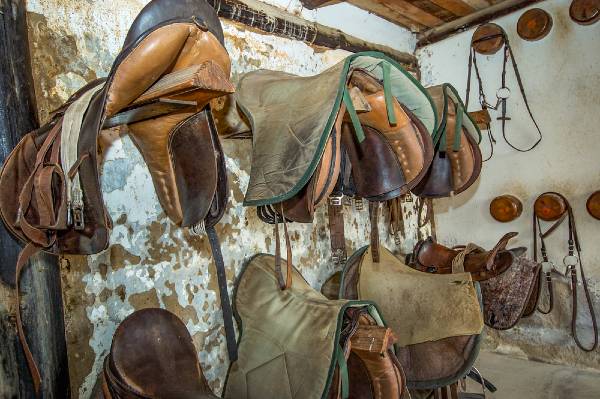
What Do You Need To Get Mold Off Horse Tack?
If your saddle or bridle has been affected by mold, a normal clean won’t be sufficient. As we know, mold spreads by producing spores and thus, a simple clean may wipe the spores around on the leather but not actually remove or kill them.
Before you start, gather some supplies. These include:
· A mild water-based saddle soap or cleaner
· Soft bristle brush or sponge, including a small brush like a toothbrush
· Multiple clean, dry cloths
· White vinegar
· Leather conditioner or oil designed for horse tack
· Water
· Measuring jug and buckets
· Disposable gloves
Set yourself up in an open area outside. Mold spores can be toxic and cause health problems if you inhale or ingest them so if there is a significant amount of mold, consider wearing a dust mask, gloves, and goggles.
See to it that there are no other items of horse tack nearby – you don’t want to spread the mold spores further. Inspect the extent of the mold growth before cleaning. If it is only surface mold, it can usually be safely removed with little or no lasting damage. However, if the mold has caused damage or staining, you may need help from a professional tack repair specialist.
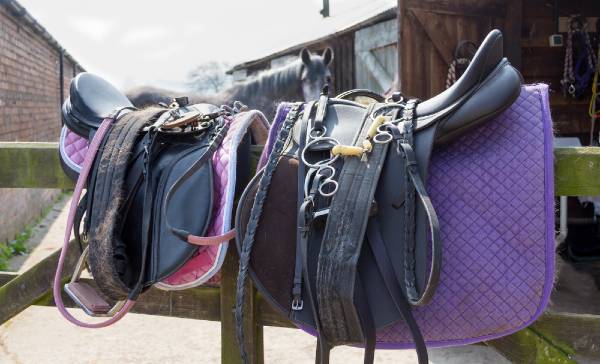
How To Get Mold Off Horse Tack
Here are the steps you need to follow to get mold off horse tack:
- First, completely disassemble your saddle or bridle. This means taking the stirrups and stirrup leathers off your saddle and undoing all buckles on your bridle so you can get to every last nook and cranny.
- Next, wipe or brush off any surface dirt or mold. A soft bristle brush can be useful to flick off the ‘white fuzz’.
- Prepare your cleaning solution. You need to mix a three-to-one ratio of water to white vinegar. For example, if you measure out 100 ml of vinegar then you will need 300 ml of water to make the solution.
- Using one of your cloths or sponges, wipe the solution over your tack. Make sure to cover every possible area and take care not to saturate the leather. The solution will kill the mold and mold spores.
- Wipe down your saddle with a different, clean, and slightly damp cloth to remove any residue or excess moisture. It is important that from this point forward you only use clean cloths or sponges on your saddle. It can also pay to remove and replace your gloves after step four as this will prevent spreading mold spores back onto your freshly cleaned tack.
- Clean your tack thoroughly with the water-based cleaner. Use fresh water, not your vinegar solution, for rinsing your sponge or cloth. Use the toothbrush to help you get into all the small crevices where mold likes to hide.
- Leave your tack to dry completely. You can leave it out in the sun for an hour or so to aid this process because if there is one thing mold does not like, it is sunlight!
- Once dry, apply a leather conditioner or oil to your tack. Give it time to soak in, and remove any excess with a clean dry cloth. This will keep the leather supple. If you have synthetic tack, you do not need to complete this step.
Make sure you thoroughly disinfect any brushes or cloths that you wish to use again to ensure that you don’t spread the mold to other items. Alternatively, use things that you can throw away afterward. (source)
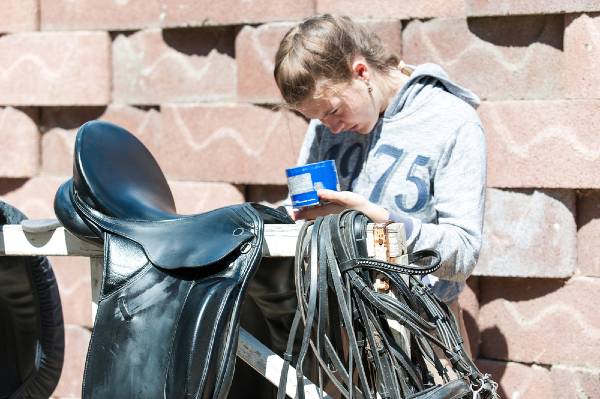
How To Get Mold Off Other Horse Equipment
Tack is not the only piece of horse equipment that can be affected by mold. Items like horse rugs, boots, and saddle pads can also fall victim. You might see the same white fuzz or multiple small black spots on these items.
The best way to get rid of mold is washing these items thoroughly. The method that you use will depend on the individual item and the severity of the mold. In addition, you will need to keep to the manufacturer’s instructions for each item.
There are many horse rug wash solutions available with disinfectant in them and many of these can simply be added to a normal wash. For items with a lot of mold, a pre-soak in the same vinegar solution as above can help.
For waterproof rugs, you will need to wash the lining of the rug by hand. Putting these sorts of rugs through a washing machine can ruin the waterproofing on the outside. Moreover, simply follow the manufacturer’s instructions for machine-washable rugs.
A pre-wash routine is best for heavily soiled rugs or saddle pads with lots of sweat or mud, . Soak the item in soapy water for a few hours or overnight then, using a scrubbing brush, scrub off the bulk of the sweat, hair, and dirt. Follow the same process for horse boots that aren’t machine washable.
Now comes the most important part: drying. Leave items out in the sun and ensure that they are 100% dry before bringing them in to prevent mold regrowth.
Final Thoughts
Indeed, prevention is much better than a cure when it comes to moldy horse tack. Clearly, the process to get mold off horse tack can be lengthy, especially if you have lots of moldy tack!
Store your tack and equipment correctly in order to prevent mold from building up and keep them in good condition for years to come,

